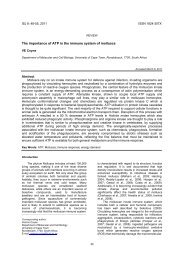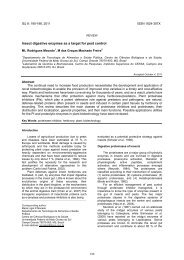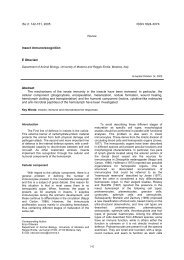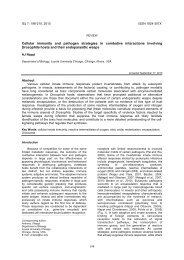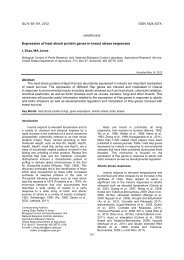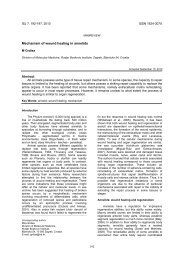Parasite-host relationship: a lesson from a professional killer
Parasite-host relationship: a lesson from a professional killer
Parasite-host relationship: a lesson from a professional killer
Create successful ePaper yourself
Turn your PDF publications into a flip-book with our unique Google optimized e-Paper software.
defense mechanisms and parasites evasion stategies<br />
altogether; the purpose of this paper is to outline<br />
some of the main parasite evasion strategies; in<br />
particular, the immunological interaction between<br />
entomopathogenic nematodes (Steinernema feltiae)<br />
and the lepidopteran model insect G. mellonella will<br />
be described. The chosen examples are focused on<br />
insect <strong>host</strong>s because of their economical and medical<br />
importance and considering their susceptibility to the<br />
symbiontic complex Steinernema-Xenorhabdus<br />
commercially available as biological insecticide.<br />
The convergence of parasitological and<br />
immunological studies also provides valuable<br />
knowledge in understanding the evolution of both<br />
parasitism and <strong>host</strong> immune system.<br />
<strong>Parasite</strong> evasion strategies: general<br />
considerations<br />
<strong>Parasite</strong>s may successfully colonize their <strong>host</strong>s<br />
by evading recognition, thus preventing immune<br />
defenses; circumvention of the <strong>host</strong> immune system<br />
can be achieved by molecular mimicry (or disguise)<br />
strategies or by colonization of young <strong>host</strong>s, or <strong>host</strong><br />
tissues, with low immunocompetence. Alternatively (or<br />
concurrently) many parasites are able to depress<br />
either cell-mediated or humoral effectors mechanisms<br />
in a process usually called interference (Lie and<br />
Heyneman, 1976).<br />
As pointed out by Götz and Boman (1985), in<br />
order to survive, a parasite must reach an equilibrium<br />
with its <strong>host</strong>; a too efficient parasite may exterminate<br />
its <strong>host</strong>s, whereas a too permissive parasite could<br />
have a low fitness and reproduction efficiency too low<br />
to guarantee its survival.<br />
In many cases, evolution and selection have<br />
finely-tuned <strong>host</strong>-parasite <strong>relationship</strong>s leading to a<br />
long survival of parasitized invertebrate <strong>host</strong>s; this<br />
process resulted in the production of vector species<br />
responsible of the transmission to human and animals<br />
of important diseases (Richman and Kafatos, 1995;<br />
Ratcliffe and Whitten, 2004).<br />
Molecular mimicry is a strategy by which<br />
parasites became antigenically closely related to the<br />
<strong>host</strong> and thus avoid to evoke <strong>host</strong> immune responses.<br />
True molecular mimicry can be defined as the<br />
endogenous production of mimicking molecules that<br />
are usually exposed on the body-surface (or cell<br />
surface) of the parasite.<br />
Despite the intuitive appeal of molecular mimicry<br />
as a mechanism of avoidance, few studies with any<br />
invertebrate parasites demonstrate a functionally<br />
protective effect of shared antigens (Bayne et al.,<br />
1987; Weston and Kemp, 1993). However, antigens<br />
such as: α-macroglobulin, immunoglobulin receptors,<br />
tropomyosin, MHC I and II antigens, blood group<br />
glycolipids and oligosaccharides, related to both <strong>host</strong>s<br />
and parasites have been identified and characterized<br />
(Smithers et al., 1969; Damian, 1991; Vellupilai and<br />
Harn, 1994).<br />
The molecular disguise, another form of mimicry,<br />
is described as the acquisition (sequestering) of<br />
molecular components <strong>from</strong> the <strong>host</strong> (Ratcliffe et al.,<br />
1985; Loker, 1994; Strand and Pech, 1995). In<br />
Biomphalaria glabrata, several studies have<br />
demonstrated the ability of Schistosoma mansoni to<br />
43<br />
acquire <strong>host</strong> plasma proteins (e.g. hemoglobin,<br />
hemagglutinins, etc.) to form a coat of <strong>host</strong> factors<br />
(Yoshino and Bayne, 1983; Dunn and Yoshino, 1991;<br />
Johnston and Yoshino, 1996).<br />
More recently, Kathirithamby and co-workers<br />
(2003) have described an alternative disguise<br />
mechanism carried out by a Strepsiptera (Stichotrema<br />
dallatorreanum) that is able to manipulate <strong>host</strong><br />
(Segestidea novaeguineae and S. d. defoliaria,<br />
Orthoptera) epidermal tissues and wraps itself within<br />
it. This sort of bag acts thus as a camouflage for the<br />
endoparasite which is recognized as self by the <strong>host</strong>.<br />
The stage of development of the <strong>host</strong> is also<br />
essential in determining the outcome of parasitization<br />
(Khafagi and Hegazi, 2004). In general, early instars<br />
larvae of insects show a reduced immune activity often<br />
due to a lower hemocytes number or to a different<br />
array of cell populations (Gardiner and Strand, 2000;<br />
Beetz et al., 2004). Due to this, parasites penetrating<br />
young <strong>host</strong>s can find a more favorable environment to<br />
overcome <strong>host</strong> defenses.<br />
Finally, as a passive strategy, some parasites are<br />
able to colonize low-reactivity tissues of the <strong>host</strong>. A<br />
good example is represented by insect parasitoids that<br />
lay their eggs, with surgical precision, in nerve ganglia<br />
of their <strong>host</strong>s into which the hemocytes do not<br />
normally circulate, so parasite embryos can develop<br />
unmolested within the <strong>host</strong> (Götz and Poinar, 1968;<br />
Salt, 1971).<br />
As mentioned above, alternative active strategies<br />
are referred as interference; in this case, parasites<br />
show an aggressive suppression or alteration of the<br />
<strong>host</strong> immune system defenses. Interference can be<br />
directed toward <strong>host</strong> humoral factors that are<br />
neutralized by the parasite or, as more commonly<br />
proposed, immunocompetent cells could be targeted<br />
instead (Loker, 1994).<br />
Another important aspect of <strong>host</strong>-parasite<br />
<strong>relationship</strong>s is <strong>host</strong> humoral depression. With respect<br />
to this, proPO system is one of the main target for<br />
many parasites or microorganisms; this is probably<br />
due to the need to neutralize its drastic and rapid<br />
effect when a <strong>host</strong> is in the presence of not self<br />
infections.<br />
Many parasitic wasps inject maternal factors into<br />
the <strong>host</strong>’s hemocoel to suppress the <strong>host</strong> immune<br />
system and to ensure successful development of their<br />
progeny; Asgari and colleagues (2003) isolated a 50<br />
kD protein <strong>from</strong> Cotesia rubecula (Hymenoptera,<br />
Braconidae) that blocked melanization in the<br />
hemolymph of its <strong>host</strong> Pieris rapae (Lepidoptera). The<br />
protein, named Vn50, is a serine proteinase homolog<br />
containing an amino-terminal clip domain; recently the<br />
authors also demonstrated that Vn50 is stable in the<br />
<strong>host</strong> hemolymph for at least 72 hrs after parasitization<br />
(Zhang et al, 2004). Using M. sexta as a model<br />
system, they found that Vn50 efficiently downregulated<br />
proPO system, by significantly reducing its<br />
proteolytic activation. This occurred without directly<br />
inhibiting and/or damaging the active phenoloxidase.<br />
According to the above description, we have obtained<br />
similar results in the tobacco budworm Heliothis<br />
virescens (Lepidoptera) larvae infected by Toxoneuron<br />
nigriceps (Hymenoptera).<br />
Gregorio and Ratcliffe (1991) demonstrated that<br />
the presence of Tripanosoma rangeli in the<br />
hemolymph of two insects (Rhodnius prolixus and



